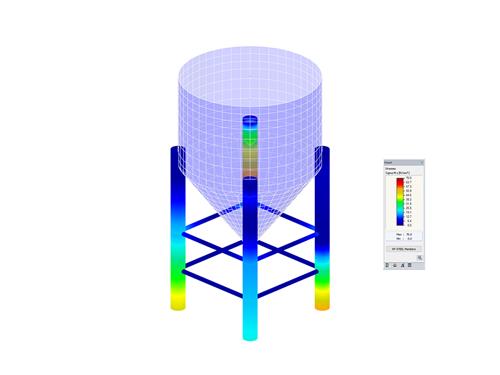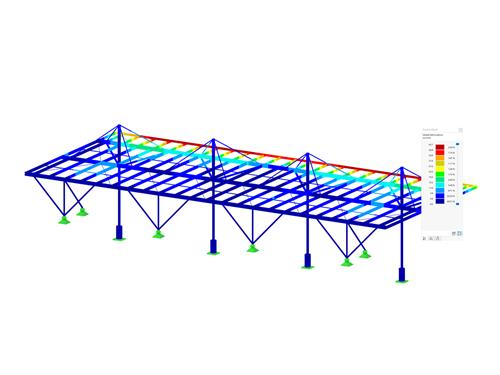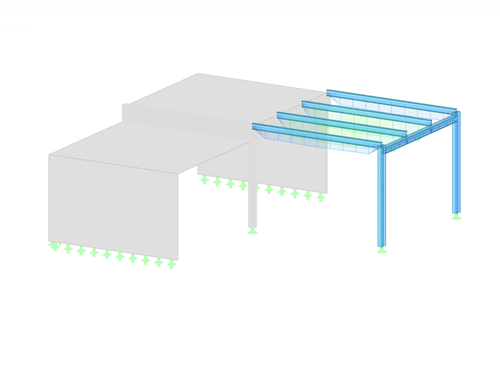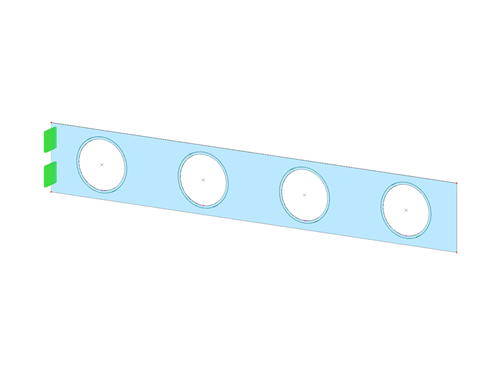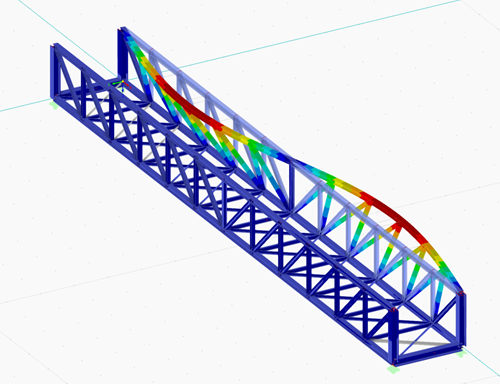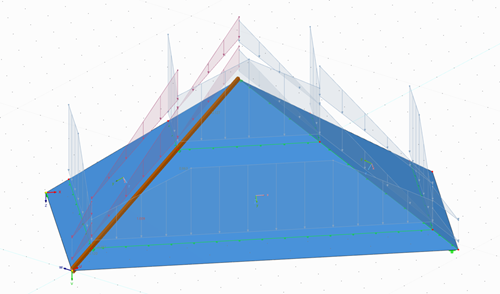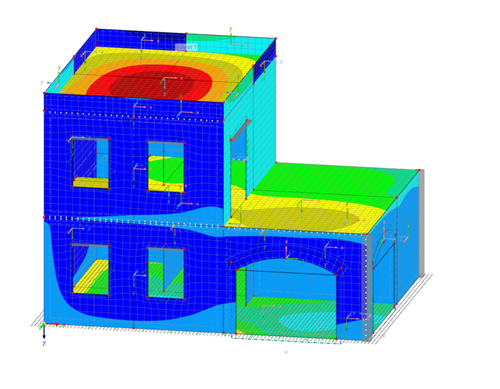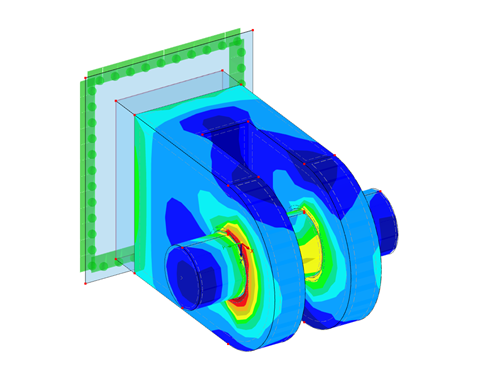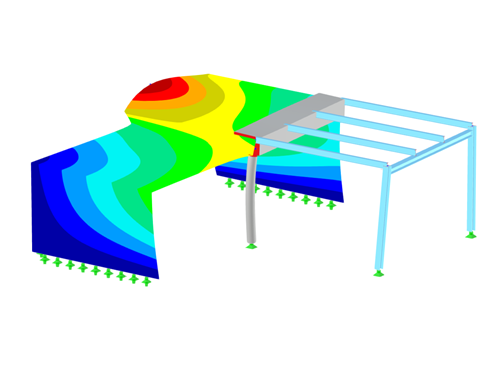The Stress-Strain Analysis add-on performs a general stress analysis by calculating the existing stresses and comparing them with the limit stresses. Strains for surfaces and solids can also be determined.
During the stress analysis, the maximum stresses of solids, surfaces, and line welds (RFEM only), as well as members are determined. The governing internal forces are also documented for each member and each surface. Furthermore, there is the option of an automatic section or thickness optimization including the update of the sections or surface thicknesses modified in RFEM/RSTAB.
This manual describes the Stress-Strain Analysis add-on for the programs RFEM 6 and RSTAB 9.
The Steel Design add-on allows you to design steel members according to various design standards. Cross-section resistance checks, stability analyses, and serviceability limit state design checks can also be performed. The input and result evaluation are completely integrated in the user interface of the structural FEA software RFEM and the frame & truss analysis software RSTAB.
This manual describes the Steel Design add-on for the RFEM 6 and RSTAB 9 programs.
In this tutorial, we would like to inform you about the essential features of the RFEM program. In the first part, a model was defined and a structural analysis was carried out. The concrete design was performed in the second part. Finally, the third part deals with the design of the steel members according to EN 1993‑1‑1 with the CEN settings.
The Timber Design add-on allows you to design timber members and surfaces according to various design standards. Cross-section resistance checks, stability analyses, and serviceability limit state design checks can also be performed. The input and result evaluation are completely integrated in the user interface of the structural FEA software RFEM and the frame & truss analysis software RSTAB.
This manual describes the Timber Design add-on for the RFEM 6 and RSTAB 9 programs.
The Masonry Design add-on activates special material models that have been developed for calculating masonry structures. This allows you to consider the masonry material in an FEM analysis.
In the calculation, internal forces and deformations are determined on the basis of stress-strain lines derived from the standardization. This means that the design is based on the standard.
This manual describes the Masonry Design add-on for the RFEM 6 program.
The Construction Stages Analysis (CSA) add-on allows you to represent the construction process of the model in the RFEM 6 program. In this way, you can add, remove, or adjust structural objects to the individual construction phases. Furthermore, you can use the add-on can to determine the sequence of the load application and the way how the load cases are combined within the construction stages.
The Form-Finding add-on finds the optimal shape of members subjected to axial forces and tension-loaded surface models. The shape is determined by the equilibrium between the member axial force or the membrane stress and the existing boundary conditions.
The resulting new model shape with impressed force conditions is made available as a universally applicable initial state for further calculation of the entire structure.
The Geotechnical Analysis add-on allows for a finite element analysis of soil solids with the suitable material laws in RFEM 6. By integrating Geotechnical Analysis into the FEA software, the soil-structure interaction can be represented computationally completely in the overall model.
With the Geotechnical Analysis, it is possible to determine the stresses and deformations of a soil solid. The input and result evaluation are integrated in the user interface of the RFEM 6 program.
This manual describes the Geotechnical Analysis add-on for the RFEM 6 program.
The Optimization & Costs/CO2 Emission Estimation add-on consists of two parts: On the one hand, you can use it to determine an optimal parameter layout for parameterized models, based on the user-defined optimization criteria. For this purpose, the artificial intelligence technology (AI) of particle swarm optimization (PSO) is used. On the other hand, you have the option to estimate the costs and CO2 emissions of a model by specifying the unit costs and emissions for the materials used in the model.
This manual describes the features of the add-on for the programs RFEM 6 and RSTAB 9. The explanations refer to RFEM, but also apply to RSTAB.
This manual describes the modeling of a stadium roof made of membranes in RFEM 6. Since the model consists of several segments, the creation of the individual segments is shown. Each segment consists of a main structure (a column, a stiffening element, cables) and a secondary structure (a membrane).
This manual describes the topics of the webinar "Steel Structure Analysis in RFEM 6 and RSTAB 9". First, it shows how to model a truss bridge. Using this example, it describes how to apply loads and load combinations, and then a stability analysis as well as design according to Eurocode 3 using the Steel Design add-on is carried out.
In the manual for the Steel Design add-on, you can find detailed explanations of all the add-on options.
The manual describes all steps in RSTAB 9. However, all explanations also apply to RFEM 6.
This manual describes the topics of the webinar Modeling and Design of Timber Structures in RFEM 6.
First, it shows how to model a hip rafter in RFEM 6 and how to apply loads, as well as how to perform timber design according to Eurocode 5. The creation of a printout report and the use of parameters and user-defined scripts are then discussed.
In the manual for the Timber Design add-on, you can find detailed explanations of all the add-on options.
This manual describes the topics of the webinar "Masonry Design of Using Finite Element Method in RFEM 6".
This webinar shows you how to model masonry structures in RFEM 6 and how to calculate them using the nonlinear orthotropic material model.
This manual describes the topics of the webinar "Modeling and Design of Solid Elements in RFEM 6".
In the webinar, a splice with bolts is modeled. It explains how you can define the contact between solids and perform a stress-strain analysis. Furthermore, the utilization of welds is also considered.
In this tutorial, we would like to inform you about the essential features of the RFEM program. In the first part, a model was defined and a structural analysis carried out. Then the concrete and steel designs were performed out in the following parts. This part now guides you through the dynamic analysis of the model according to EN 1998-1 with the CEN settings.
